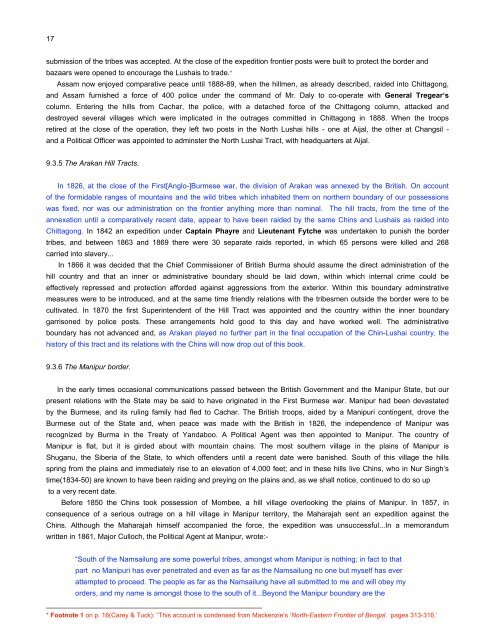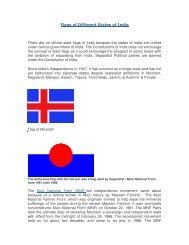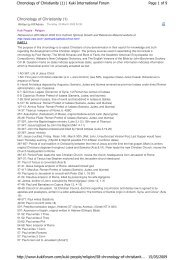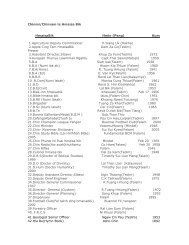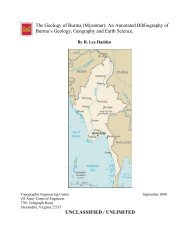- Page 1 and 2: THE ZO PEOPLE OF BANGLADESH, BURMA
- Page 3 and 4: ABSTRACT Those who are known to the
- Page 5 and 6: 'eerE ufl.lc jo dBW (I I0! 986 tL6
- Page 7 and 8: BRIEF DESCRIPTION AND EXPLANATION O
- Page 9 and 10: ON CHIN/ZO SOLDIERS AND BURMA THE B
- Page 11 and 12: NOTES As the subjects mentioned bel
- Page 13 and 14: 9.2.1 Physical Characteristics 9.2.
- Page 15 and 16: 9.13.3 Suzerainty of the Tashons an
- Page 17 and 18: 17.0 PEOPLE 16.2 OUTBREAK OF THE CI
- Page 19 and 20: 20.4.4 TOBACCO CULTIVATION 20.4.5 C
- Page 21 and 22: TABLE 17/A Female Lines in the Mang
- Page 23 and 24: SOME OLD AND NEW SPELLINGS OF TRIBA
- Page 25 and 26: 2 following terms: Asho, Sho/Cho, L
- Page 27 and 28: 4 estimate that there were 350,000
- Page 29 and 30: 6 29°C. Since Chin State has sever
- Page 31 and 32: 8 which is broadcast daily from Ran
- Page 33 and 34: 10 establishment of tourist's huts
- Page 35 and 36: 12 ‘Still further westward in the
- Page 37 and 38: 14 southern villages are dealth fro
- Page 39: 16 1871-72 country during the ensui
- Page 43 and 44: 20 hostility. Captain Raikes arrive
- Page 45 and 46: 22 9.5.3 Attempted Negotiations wit
- Page 47 and 48: 24 numbers, using many rifles and a
- Page 49 and 50: 26 from Pakokku, and, after some sh
- Page 51 and 52: 28 Nyerlon, and the younger branche
- Page 53 and 54: 30 300 guns; the actual losses of t
- Page 55 and 56: 32 Burma. Thetta was the chief offe
- Page 57 and 58: 34 marching to Haka. As neither Fal
- Page 59 and 60: 36 [Limkhai] where it was joined by
- Page 61 and 62: 38 submission and friendship to the
- Page 63 and 64: 40 that the open season was at hand
- Page 65 and 66: 42 the entire operation, and to the
- Page 67 and 68: 44 convince the Chiefs of the futil
- Page 69 and 70: 46 tributary to Falam. The people t
- Page 71 and 72: 48 commanded by Major Keary, D.S.O.
- Page 73 and 74: 50 9.19.9 Tour in the Nwengal count
- Page 75 and 76: 52 To assist him, each Chief appoin
- Page 77 and 78: 54 impossible, they could more than
- Page 79 and 80: 56 Getting Water the water-supply.
- Page 81 and 82: 58 12.2 BOWS AND ARROWS Bows and ar
- Page 83 and 84: 60 found the exact size and shape o
- Page 85 and 86: 62 13.3 ARMED RESISTANCE MOVEMENTS
- Page 87 and 88: 64 administrative head at the Chin-
- Page 89 and 90: 66 neighbouring foreigners. Again,
- Page 91 and 92:
68 public, any legislation may be a
- Page 93 and 94:
70 14.4.4. [4] THE TERRITORY OF CHI
- Page 95 and 96:
72 In the sands of time testify To
- Page 97 and 98:
74 I “We solemnly affirm and reso
- Page 99 and 100:
76 made into Kaya State, were de ju
- Page 101 and 102:
78 WITH COLLEAGUE AUNG SAN “...Co
- Page 103 and 104:
80 Besides the formal meetings, man
- Page 105 and 106:
82 3. Hon‘ble Sao Sam Htun, Shan
- Page 107 and 108:
84 6. Hon‘ble Mahn Win Maung, Min
- Page 109 and 110:
86 Burman soldiers to fight on the
- Page 111 and 112:
88 the cause of some Zo tribes, but
- Page 113 and 114:
90 were their tongues, which poured
- Page 115 and 116:
92 convincing. According to Lehman
- Page 117 and 118:
94 “dialects“ of the rest 10 tr
- Page 119 and 120:
96 found the inhabitants divided in
- Page 121 and 122:
98 ledgement). My mother and I are
- Page 123 and 124:
100 researcher or an outsider. Howe
- Page 125 and 126:
102 third or fourth child is and so
- Page 127 and 128:
104 17.8.3. TOWARDS ZO UNIFICATION
- Page 129 and 130:
106 rich language to become an effe
- Page 131 and 132:
108 Whatever the differences in the
- Page 133 and 134:
110 (Modification) Order, 1956 has
- Page 135 and 136:
112 him that the community, which c
- Page 137 and 138:
114 and there is no clinching evide
- Page 139 and 140:
116 women although there are a numb
- Page 141 and 142:
118 It is also theorized that socia
- Page 143 and 144:
120 1967 made an attempt to abolish
- Page 145 and 146:
122 18.0 RELIGION 18.1 Ancient Reli
- Page 147 and 148:
124 with down-cast eyes. Then Pasia
- Page 149 and 150:
126 Magazine(1968/1969), pp. 122-13
- Page 151 and 152:
128 from the USA arriving at Rangoo
- Page 153 and 154:
130 (6) Dr. J. G. Woodin … … No
- Page 155 and 156:
132 18.3.8 Zones and Parishes Zones
- Page 157 and 158:
134 gathering(see PHOTOS 11-A & 11-
- Page 159 and 160:
136 intimate friends. One may compo
- Page 161 and 162:
138 although the songs may have bee
- Page 163 and 164:
140 British annexation, as it had a
- Page 165 and 166:
142 own share is usually just a cup
- Page 167 and 168:
144 tions. Except in the far south
- Page 169 and 170:
146 the Chin axe is superior to our
- Page 171 and 172:
148 20.4.6 SMOKING The Thado and So
- Page 173 and 174:
150 and much of which, instead of a
- Page 175 and 176:
152 Muslims, Chins, Kachins, Karens
- Page 177 and 178:
154 PHOTO AND MAP CREDITS Map 1 (Fr
- Page 179 and 180:
156 Sungh te address form used by a
- Page 181 and 182:
158 * Member of Committee for Resto
- Page 183 and 184:
,i ) i /" i f T':"+- !,) )) ' t----
- Page 185 and 186:
,\ i tI I ^q .,uils,, I oPlil Vhl I
- Page 187 and 188:
tl !* i/i .{t -*rC'"- ,1' Its .tt Y
- Page 195 and 196:
E9 dld Ft 5; F5 i: 3i !i FS - 3 e
- Page 197 and 198:
I ! l 9 I 6 z
- Page 199 and 200:
* I E'IBVI t0/pa) (0t0r afi6ueN oae
- Page 201 and 202:
Fi'aTG'6'FA U RET 6N = -q- q-E- -aJ
- Page 203 and 204:
E o F F F I . z F a 6 F I (l B z F
- Page 205 and 206:
9 i O 5 !3 : 5 SF e;::s:egi:;; 4-==
- Page 207 and 208:
F NIN ! E J6 N I' 'b ?l @ Fl t4 Fl
- Page 209 and 210:
3 ,E -f 8,9 c 3s.c !> 'a N 9ot $ 6
- Page 211 and 212:
(oz*, Esd co< t:> C') ri - r ttl t
- Page 213 and 214:
I (sc0 fis - lrl -J I '-== .:A;"i )
- Page 215 and 216:
a.= o, (sm =r ^-c < \JF s c.) d\!.d
- Page 217 and 218:
=-J (E6 ^c< L.,F _?x o) I c c Aa =
- Page 219 and 220:
(; -) () _?x o, - ltl ] --l (gc0 fi
- Page 221 and 222:
E :;jac6cF^:-; =l=:119! 9l ;!iEi!i
- Page 223 and 224:
-{ a') =7 7==^,^.7 j =! | : 3=;. ;
- Page 225 and 226:
io rr6 6-! ..r .i ro Yc Nf \c \. .c
- Page 227 and 228:
-===,:===2J=< =-:a= aza-a -tC) o)s6
- Page 229 and 230:
; ! Y-,-, : 5 i ?.- .: .; ri' 1'.-
- Page 231 and 232:
G g' :N >9 . E> ;l 6 a z J z z J F
- Page 233 and 234:
z 9.. R.'n.. a j iEss!:gi! ;pfs v)
- Page 235 and 236:
:< bE UF-cn3 \=F= Lu..< 'qt.l!xi .:
- Page 237 and 238:
1.3= -= Fl " ii= R' |- I n'---' \f,
- Page 239 and 240:
z O 5 ?e! F !-g: \ ::- -a t+-< 'l -
- Page 241 and 242:
z N E q F z .=e;EigE3$gti sffFEEEsg
- Page 243 and 244:
z N N r N ,r-ti \r-C: E- ,-t .f, =
- Page 245 and 246:
z \.. t : 1i -": 36-< v\o\ =-'n-- N
- Page 247 and 248:
-l zl N- N -_N =m-< 5? uR =?'v.'- N
- Page 249 and 250:
Y-r!. 5 Z . I . T. t---,i = Jm-< Ns
- Page 251 and 252:
z Nrt] 03 'aFj A3R lss "c!g {E^ I r
- Page 253 and 254:
E z F A' 4 a E
- Page 255 and 256:
]rrslttuls Jo eEe;uac:a; t'08 0'r8
- Page 257 and 258:
HOW THE ZO PEOPLE IN TIDDIM & TONZA
- Page 259 and 260:
From: Son Suantak Reply-To: chinla
- Page 261 and 262:
-----------------------------------
- Page 263 and 264:
THEORIES ON THE ORIGIN OF THE SAILO
- Page 265 and 266:
the Sizangs are called “Sihzang P
- Page 267 and 268:
APPENDIX A-2 LOPHEI KHUA, PU KIM LE
- Page 269 and 270:
Pa dawi ah thi ahi manh ka ci ka la
- Page 271 and 272:
cr' \ J A iJ s (t On o e q t i a,\
- Page 273 and 274:
- F' tv ' -ts, Jl )-v ) TQO de6 4 t
- Page 275 and 276:
t) 'li !) f -a-- Tylt-a 0,"'^+ tr ,
- Page 277 and 278:
: I 5 j : ,.- 3: :)s Y \I \" i .s s
- Page 279 and 280:
$9" .s qrl.l EZ o J.)r E} s\
- Page 281 and 282:
s F K 3t 3; s g E F p s-F; t- q.{ e
- Page 283 and 284:
Imphal, Nov 1, 2008 APPENDIX B CHIE
- Page 285 and 286:
as something of a model state and r
- Page 287 and 288:
the forces numbering 800 men, the T
- Page 289 and 290:
APPENDIX G THU KHUPNA LA A-KAI(SLOW
- Page 291 and 292:
APPENDIX H
- Page 293 and 294:
01"/*2*#+13 01&,&$+/ 4& 5#-&)" 4."
- Page 295 and 296:
01"/*2*#+13 01&,&$+/ 4& 5#-&)" 4."
- Page 297 and 298:
01"/*2*#+13 01&,&$+/ 4& 5#-&)" 4."
- Page 299 and 300:
UniBook nicode.org/unibook/) Pau Ci
- Page 301 and 302:
01"/*2*#+13 01&,&$+/ 4& 5#-&)" 4."
- Page 303 and 304:
01"/*2*#+13 01&,&$+/ 4& 5#-&)" 4."
- Page 305 and 306:
!"#$%$%& '()*"(+$", #)( -)%" ./(0,
- Page 307 and 308:
APPENDIX I Date of Origination, Fre
- Page 309 and 310:
Date of Orieination, Frequency and
- Page 311 and 312:
APPENDIX J TREES Ash Oak(several va
- Page 313 and 314:
Bulbul(ordinary red-vented and gree
- Page 315 and 316:
APPENDIX K Conclusion “Thukhupna
- Page 317 and 318:
ffiw ffi 'i*;r*''ffruE *riir'f i; n
- Page 319 and 320:
APPENDIX L VETERANS OF SIYIN CONTIN
- Page 321 and 322:
19. Hau Mong, killed in,action ai K
- Page 323 and 324:
L Phung taw iiam ngawl, ngai tow li
- Page 325 and 326:
51. Tuang Vum 52. Lam Khup killed i
- Page 327 and 328:
VII. THANG NUAI VETE NS As told to
- Page 329 and 330:
APPENDIX M-1 Subj: [ZOMIFLA] Nu Lua
- Page 331 and 332:
APPENDIX M-2 WE NEED KNOWLEDGE FOR
- Page 333 and 334:
authorities in 1940, is most reliab
- Page 335 and 336:
enough for us to see things in a pr
- Page 337 and 338:
Chins ever took place on that day.
- Page 339 and 340:
elements of the 4th Punjabis and 5t
- Page 341 and 342:
After briefly serving in the South
- Page 343 and 344:
Natal, but not far enough forward t
- Page 345 and 346:
and 1889), the Chin Lushai Expediti
- Page 347 and 348:
Lieut.-Colonel John Shakespear Born
- Page 349 and 350:
o -a---EEFEi ,l( EIEFEEE*'FFF t) cl
- Page 351 and 352:
JNiIIiIiftIUCV CNOACNVd IIHI -""E!!
- Page 353 and 354:
REPORT OF THE FRONTIER AREAS COMMIT
- Page 355 and 356:
REPORT OF THE FRONTIER AREAS COMMIT
- Page 357 and 358:
REPORT OF THE FRONTIER AREAS COMMIT
- Page 359 and 360:
REPORT OF THE FRONTIER AREAS COMMIT
- Page 361 and 362:
REPORT OF THE FRONTIER AREAS COMMIT
- Page 363 and 364:
REPORT OF THE FRONTIER AREAS COMMIT
- Page 365 and 366:
REPORT OF THE FRONTIER AREAS COMMIT
- Page 367 and 368:
REPORT OF THE FRONTIER AREAS COMMIT
- Page 369 and 370:
REPORT OF THE FRONTIER AREAS COMMIT
- Page 371 and 372:
REPORT OF THE FRONTIER AREAS COMMIT
- Page 373 and 374:
REPORT OF THE FRONTIER AREAS COMMIT
- Page 375 and 376:
CHIN COMMUNITY(GERMANY) APPENDIX S
- Page 377 and 378:
the Army Chief. Ne Win and his prot
- Page 379 and 380:
statue from the Arakan City or Mrau
- Page 381 and 382:
APPENDIX U-I 19TH CENTURY WARS AND
- Page 383 and 384:
APPENDIX U-2 INDIA & NWF First Myso
- Page 385 and 386:
1890 Lushai Expedition 1890[1889-92
- Page 387 and 388:
APPENDIX V FEASTING AND MEAT DTYIfI
- Page 389 and 390:
Ischd,. Bioileft (cb&,) A}}exNr < v
- Page 391 and 392:
A?PeN}'r,(V Dioisiov amans tlu Zalw
- Page 393 and 394:
flPe.l> i* v Khuang hau, Owaer of i
- Page 395 and 396:
i*PEt$i( ! anoW tlz Zakau Ckirc ol
- Page 397 and 398:
^t?ENS\x V Dioi*ion arnonq the Zaha
- Page 399 and 400:
klrEt>x v Diilirion amory the Zaha
- Page 401 and 402:
$tErsi
- Page 403 and 404:
Atrersi:4 v Ilbi*ion. anang ttz Zdw
- Page 405 and 406:
o z o- UJ Eli > = !4 ai "| d
- Page 407 and 408:
i CONTENTS Page PREFACE............
- Page 409 and 410:
iii LIST OF PHOTOGRAPHS 1. HAKA COO
- Page 411 and 412:
APPENDIX Y INDIA GENERAL SERVICE ME
- Page 413 and 414:
of a party of Tibetans who had esta
- Page 415 and 416:
the operations in the Chin Hills, r
- Page 417 and 418:
(http://www.militariamart.com/index
- Page 419 and 420:
MAJOR GENERAL TUANG ZA KHAI (Retire
- Page 421 and 422:
take defence positions behind the I
- Page 423 and 424:
village. Enemy strength was estimat
- Page 425:
:' .: t., .,t ::*' s. l ,l t' fF


